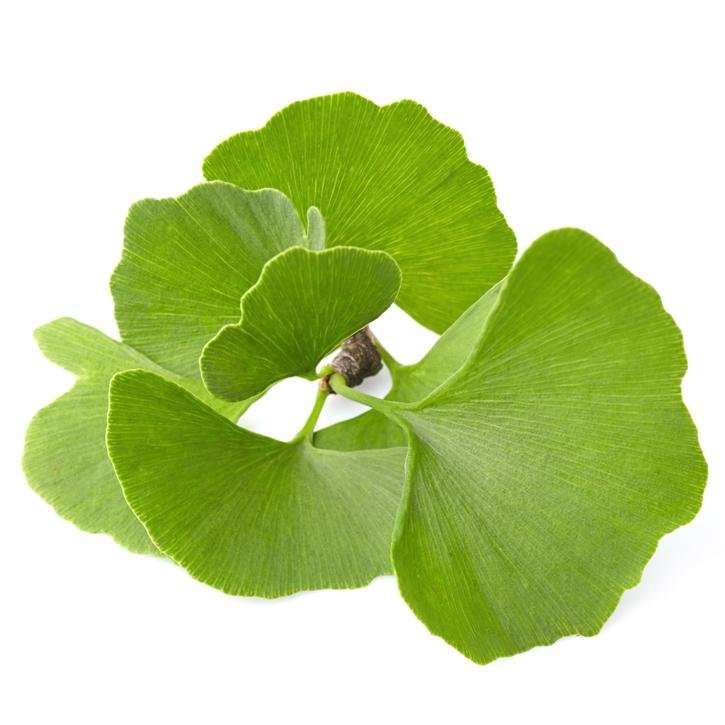Description
Dioecious tree (male and female are different trees), deciduous, branching, which can reach 40 meters of height. Quite corky grayish brown or dark brown bark, with marked ridges and grooves. Simple light green leaves, turning yellow in the autumn, flabellate, coriaceous, glabrous, usually bilobed, but they can also be almost whole or very divided, with a central notch in clusters of 3-5 leaves. Dioecious flowers, in different feet, the yellow male ones, cylindrical catkins gathered, very numerous and are born in short shoots, the solitary and long stalks female ones are usually born in pairs in the axils of scale bracts, yellowish brown colored and fleshy texture, becoming grayish green when they ripe. Ginkgo is characterized by special reproductive organs which appear after about 20-35 years. After fertilization by antherozoids, it gives an egg of drupaceous consistency. Seeds (incorrectly called fruits) are drupe, round or ellipsoid, about 2-3 cm in diameter, yellowish, with a fleshy outer and edible layer, once ripe when it falls to the ground and rots, it has an unpleasant smell (as rancid butter) due to the butyric acid which contains. It includes 1-2 seeds which have a silvery sheen. The female tree might have seeds without pollination (sterile). It belongs to the Ginkgoaceae family.
It is a tree coming from eastern China and is very rare in the wild. It blooms in early spring and produces fruit after more than 25-30 years, which mature in autumn. Leaves are harvested in spring. It bears changes of climates. Its natural habitats are mountain valleys with temperate climate, in well-drained and cool grounds but with a certain degree of humidity, because it cannot withstand well the drought, but it is very adaptable, so it grows too in poor grounds, compact soils, soils with various pH, heat, salt drizzle in winter and air pollution.
Ginkgo is a sacred tree of the East, object of veneration, is a symbol of unity of opposites, seen by some as a symbol of changelessness, holder of miraculous power, bearer of hope and immeasurable past, a symbol of love. Due to its properties, is related to longevity. The old Ginkgos are revered as a god in Japan. Besides, ginkgo is the oldest tree of all existing in the world. The reason of its survival, apart from a natural resistance to parasites and the unpleasant odor of its fruits that made that were not eaten by any animal, is due to the fact that in the East it has been considered a sacred plant, reason which justifies its plantation around the temples and a great reverence was paid it.
Part used
The leaves, harvested in spring.
Indications
Internal use
- Cerebral vascular deficiency. It improves functional disorder conditions (cephalalgia, vertigo, memory and diction problems, tinnitus) and other behavior disorders (disorientation, aggressivity, incoherence, anxiety, etc.).
- Senile dementia, vascular dementia, Alzheimer’s disease.
- Reduction of the intellectual performance, difficulty to concentrate, memory loss.
- Depression in third age.
- Prevention of arteriosclerosis and cerebral thromboembolism.
- Cerebrovascular accident and cranioencephalic traumatism.
- Arterial hypertension.
- Vascular cephalalgia, vertebrobasilar insufficiency.
- Arterial peripheral insufficiency. Intermittent claudication.
- Microangiopathies, diabetic retinopathies and uveitis.
- Venous insufficiency- varicose veins, hemorrhoids, capillary fragility, phlebitis, thrombophlebitis.
- Erectile dysfunction (impotence) by arterial insufficiency. Sexual dysfunctions induced by the use of antidepressants, especially inhibitor antidepressants of serotonin re-uptake.
- Prevention of the parkinsonism.
- Vertigo and vascular tinnitus, it helps to treat the cochlear deafness (which originates in the brain).
- Neuropathy recovery.
- Post myocardial infarction recovery.
- Asthma and allergies.
- Skin diseases- psoriasis.
- Oliguria and prostatitis.
- Premenstrual syndrome.
- Liver fibrosis. It stops the evolution of liver fibrosis related to chronic hepatitis B.
External use
- Skins diseases: sunburns, dry eczema, psoriasis, acne, some allergies on the skin, skin dryness, ichthyosis.
- Hay fever (spray).
- Parodontopathies.
Bibliography
Matière Médicale. RR Paris- H. Moyse. Masson 1981.
Fitoterapia Aplicada. J.B. Peris, G. Stübing, B.Vanaclocha. Colegio Oficial de Farmacéuticos de Valencia 1995.
Fitoterapia: Vademecum de Prescripción. Plantas Medicinales. Colaboran: Asociación española de médicos naturistas. Colegio Oficial de Farmacéuticos de Vizcaya.
Plantas Medicinales. Thérapeutique-Toxicité. Christiane Vigneau. Masson, Paris 1985.
100 Plantes Medicinales. Max Rombi. Romart 1998.
The Complete German Commission E Monographs. Therapeutic Guide To Herbal Medicines. Mark Blumenthal. American Botanical Council 1998.
Farmacognosia. G.E. Trease y W. C.Evans. CECSA.
Farmacognosia. Fitoquímica Plantas Medicinales. Jean Bruneton. 2ª Edición. Ed. Acribia SA. 2001.
Farmacopea Herbolaria de los Estados Unidos Mexicanos, 2001.
Revista de Fitoterapia 2000; I:43-46.
Pharmacognosy, Phytochemistry, Medicinal Plants.Jean Bruneton. Lavoisier publishing.
Botanical Influences on Illness. Melvyn R. Werbach, MD and Michael T. Murray, N.D.
